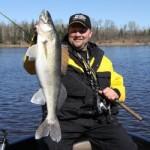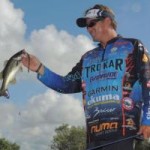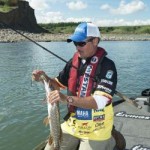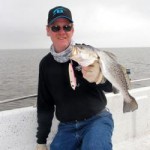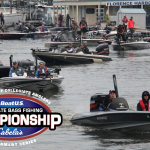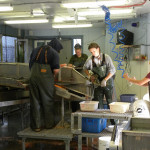By Nathan Shore
from The Fishing Wire
All summer walleyes have been in deep water following baitfish around, but come September and the start of cooler weather many those baitfish head back to shallower water to spawn. Walleyes follow, and flipping and pitching a jig in shallow water becomes the No. 1 tactic for boating a big limit.
Walleyes readily attack a swimming jig over their heads when ciscoes are spawning in the shallows.
“Baitfish like ciscoes come back out of open water to spawn in fall,” said tournament pro Jon Thelen. “That’s why walleyes make that shallow movement when water temperatures start cooling off. I begin looking at the same spots I fished in spring, when other species were spawning. Prime locations are rockpiles and anywhere the bottom gets harder beyond a weed edge.”
Ciscoes (also called tulibees) spawn above gravel or rock, generally in depths of 10 to 15 feet. Actual spawning occurs as water temperatures dip to about 50°F, but ciscoes come in prior to that to stage. And, ciscoes aren’t the only baitfish busting shallow moves in fall.
“Other baitfish that come in during fall are spottail and emerald shiners,” Thelen said. “And you’re trying to match all the other shiner species that stay shallow all year, too.”
The arrival of ciscoes, spottails, and emeralds to shoreline areas can draw the majority of the walleye population out of deep water. Silvers are black-silver, goldens are black-gold, emeralds are green-pearl and ciscoes have blue or gray backs with pearl to gray bellies. Thelen matches those basic color patterns most of the time, but notes that at times the fish want bright colors or glow patterns, especially in dark water or during low-light periods.
For fall shallow jigging, Thelen goes to a Lindy Watsit or Fuzz-E Grub, but there’s no long-line trolling or long-distance casting in his bag of tricks for fall walleyes.
“When walleyes are on the chew this time of year, they don’t mind a jig passing by several feet over their head, so I often pitch and swim the jig back to the boat,” he said “You can get away with vertical jigging and moving the boat around when fish are staging out on deeper transitions between the basin and the structures these baitfish spawn on, but when you’re seeing ciscoes dimpling the surface over depths of 10 to 17 feet, I like to make little flips of about 30 feet. With a short cast, the retrieve stays close to vertical, but you add a little horizontal to the package as you bring it back.”
Tipping jigs with a 3-inch rainbow shiner or a 4-inch redtail chub is the way to go in fall.
“The boat is moving slowly and I’m flicking the jig out with soft casts to keep the bait secured on the hook,” Thelen said. “Sometimes I hop it aggressively, but I generally start slow.”
He may simply swim the jig slowly just off the bottom, making short flips and allowing the jig to sink. The short flips allow him to cover every depth more precisely than with a long cast. A short flip gives him better accuracy in knowing the depth a fish came from, allowing him to refine his pattern for the day, as well as more precisely re-target that depth.
During daytime hours, Thelen looks for spots on the deep side of rockpiles, reefs and gravel bars.
Big walleyes are easier to catch if you sweeten the jig with a live minnow.
“Ciscoes spawn around the end of September in most areas,” he said. “They begin to come in during the first full moon in September. By the full moon in October, action is phenomenal. Good fishing continues in shallow water right through November and you can begin sight fishing those same fish at first ice.”
Thelen prefers color combos of blue-white, black with gold flake, metallic gold, and green pumpkin, natural colors that represent the shiners and ciscoes walleyes expect to see in shallow water.
“Crayfish are always a backup option, so brown-orange works, too,” he said. “Fish can decipher colors really well in water less than 15-feet deep, however, a bright gold, bright orange or flashy metal-flake pattern can be natural, especially in the evening, under heavy cloud cover and on windy days.”
Thelen determines jig weight and size depending on the body of water he’s fishing, but most of the time he sticks to 1/8- to ¼-ounce jigs. A 3/16-ounce Watsit can be an important size this time of year, too.
“Drop speed is critical,” he said. “Aggressive walleyes will accept faster drop speeds, but wary, finicky fish won’t. Try to match the depth to jig weight so the jig swims just above a walleye’s head, right in his wheelhouse, You don’t want the jig to fall out of that zone very quickly.”
Thelen uses a medium-action, 6-foot, 6-inch spinning rod with 10-pound braid and a short, 2- to 3-foot leader of Silver Thread Fluorocarbon. He prefers a braid that’s easy to see and sensitive. Walleyes bite on the drop a lot during fall and it’s generally an aggressive ‘thunk,” and he sets the hook the moment he feels the second bite.
“Minnows are bigger in fall, and bulked-up jigs with plastic bodies like the Fuzz-E Grub and Watsit match those sizes better and slow the drop of the jig, but can interfere with hooksets unless you make sure the fish have a firm grip on the whole package.”
